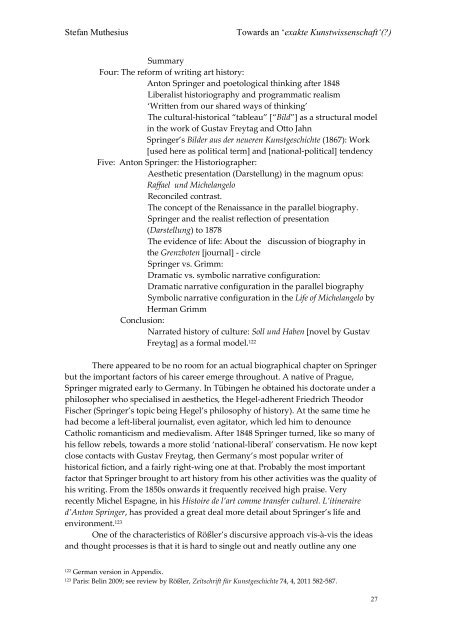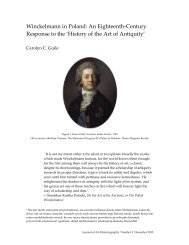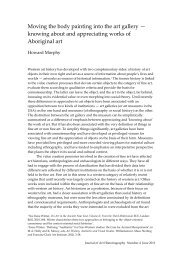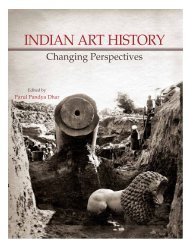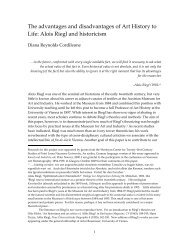9/SM1 - Journal of Art Historiography
9/SM1 - Journal of Art Historiography
9/SM1 - Journal of Art Historiography
You also want an ePaper? Increase the reach of your titles
YUMPU automatically turns print PDFs into web optimized ePapers that Google loves.
Stefan Muthesius<br />
Towards an ‘exakte Kunstwissenschaft‘(?)<br />
Summary<br />
Four: The reform <strong>of</strong> writing art history:<br />
Anton Springer and poetological thinking after 1848<br />
Liberalist historiography and programmatic realism<br />
‘Written from our shared ways <strong>of</strong> thinking’<br />
The cultural-historical “tableau” [“Bild”] as a structural model<br />
in the work <strong>of</strong> Gustav Freytag and Otto Jahn<br />
Springer’s Bilder aus der neueren Kunstgeschichte (1867): Work<br />
[used here as political term] and [national-political] tendency<br />
Five: Anton Springer: the Historiographer:<br />
Aesthetic presentation (Darstellung) in the magnum opus:<br />
Raffael und Michelangelo<br />
Reconciled contrast.<br />
The concept <strong>of</strong> the Renaissance in the parallel biography.<br />
Springer and the realist reflection <strong>of</strong> presentation<br />
(Darstellung) to 1878<br />
The evidence <strong>of</strong> life: About the discussion <strong>of</strong> biography in<br />
the Grenzboten [journal] - circle<br />
Springer vs. Grimm:<br />
Dramatic vs. symbolic narrative configuration:<br />
Dramatic narrative configuration in the parallel biography<br />
Symbolic narrative configuration in the Life <strong>of</strong> Michelangelo by<br />
Herman Grimm<br />
Conclusion:<br />
Narrated history <strong>of</strong> culture: Soll und Haben [novel by Gustav<br />
Freytag] as a formal model. 122<br />
There appeared to be no room for an actual biographical chapter on Springer<br />
but the important factors <strong>of</strong> his career emerge throughout. A native <strong>of</strong> Prague,<br />
Springer migrated early to Germany. In Tübingen he obtained his doctorate under a<br />
philosopher who specialised in aesthetics, the Hegel-adherent Friedrich Theodor<br />
Fischer (Springer’s topic being Hegel’s philosophy <strong>of</strong> history). At the same time he<br />
had become a left-liberal journalist, even agitator, which led him to denounce<br />
Catholic romanticism and medievalism. After 1848 Springer turned, like so many <strong>of</strong><br />
his fellow rebels, towards a more stolid ‘national-liberal’ conservatism. He now kept<br />
close contacts with Gustav Freytag, then Germany’s most popular writer <strong>of</strong><br />
historical fiction, and a fairly right-wing one at that. Probably the most important<br />
factor that Springer brought to art history from his other activities was the quality <strong>of</strong><br />
his writing. From the 1850s onwards it frequently received high praise. Very<br />
recently Michel Espagne, in his Histoire de l’art comme transfer culturel. L’itineraire<br />
d’Anton Springer, has provided a great deal more detail about Springer’s life and<br />
environment. 123<br />
One <strong>of</strong> the characteristics <strong>of</strong> Rößler’s discursive approach vis-à-vis the ideas<br />
and thought processes is that it is hard to single out and neatly outline any one<br />
122<br />
German version in Appendix.<br />
123<br />
Paris: Belin 2009; see review by Rößler, Zeitschrift für Kunstgeschichte 74, 4, 2011 582-587.<br />
27


